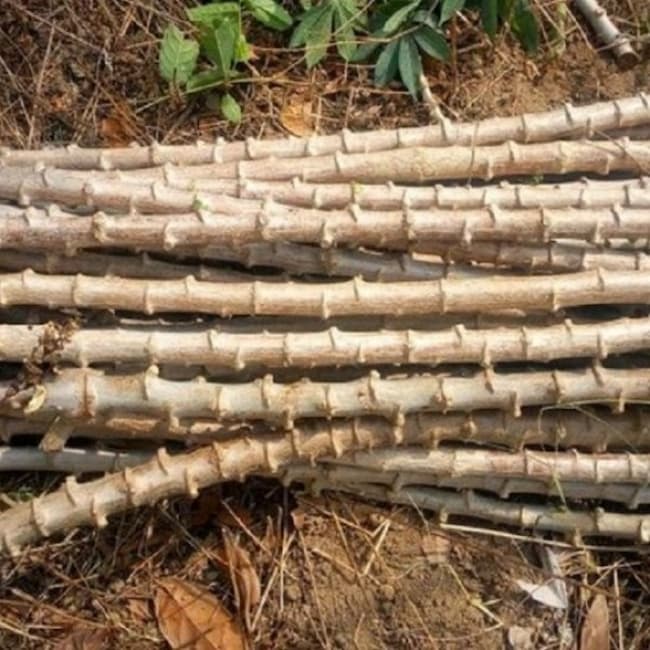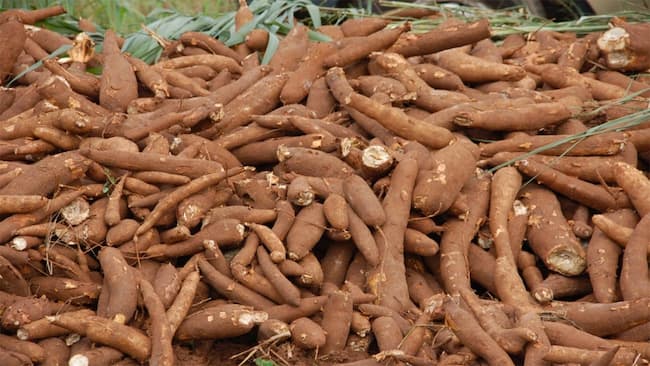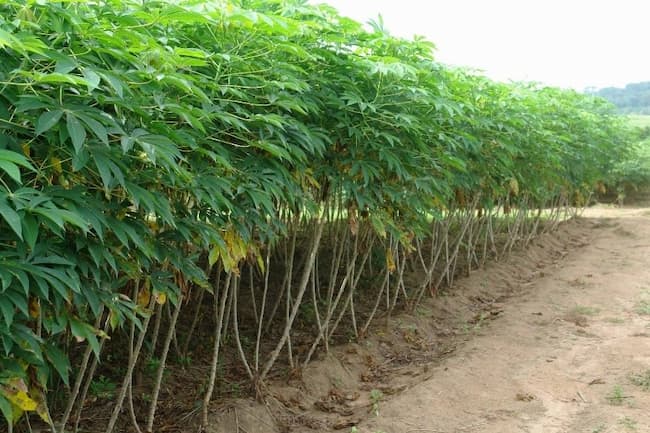Cassava is one of the most common food crops grown and consumed in Nigeria and many parts of Africa. Here’s how to plant, grow, and harvest it.
It can be planted alone or with many other crops, like maize, groundnuts, vegetables, and rice.
Growing cassava does not require intense labour. It usually requires 75 to 125 person-days per hectare from land preparation to harvesting. The cassava roots can be harvested 9 to 18 months after planting.
Recommended varieties
The International Institute of Tropical Agriculture and NextGen Cassava Breeding project are promoting improved and high-yielding cassava stems that are cassava mosaic disease-resistant,
One of these stems, TME 419, is a variety that is popular among farmers in Nigeria.
Other five varieties available in the market are: IBA961632 (Farmer’s Pride), IBA980581 (Dixon), CR36-5 (Ayaya), IBA070593 (Sunshine), and IBA980505 (Fine face).

When to plant cassava
One of the keys to getting high yields form cassava is knowing the appropriate time to plant. Knowing the best planting period will reduce losses and improve returns.
Findings of a study carried out and published in the scientific journal ‘Plant Disease’ showed that the long rainy season is the best planting season for cassava farmers.
In Nigeria, the long rainy season is from March to July.
The new research shows that there is a much higher degree of infection by cassava brown streak disease in the short rainy season, which runs from October to December than during the long rainy season.
Do you know what happens when you replant stems from the previous cassava crop year after year?
It is a common practice among smallholder farmers to reuse stem cuttings from previous crops for planting in the new season.
The study discovered that the recycling of planting material in this way can lead to increase in virus infection increases from one season to the next.
Choosing and preparing a planting site
Cassava grows best in areas with deep and well-drained loamy soils, adequate rainfall, and warm and moist climatic conditions. The best farmland for cassava is flat or gently sloping. Steep end to erode easily and not very good areas for growing cassava.
The only preparation required is clearing of the land to allow sunlight to reach the ground and to remove weeds and undergrowth, which might otherwise compete with the plants.
How to plant cassava
Cassava is either planted as a single crop or intercropped with other crops like maize, legumes, vegetables, rubber, oil palm or other plants.
READ ALSO: 2021: NiMET Warns Of Drought, Food Shortage
Intercropping reduces the danger of loss caused by unfavourable weather and pests by spreading the risk over plants with different susceptibilities.
Cassava is planted exclusively from cuttings. Ensure each cutting is at least 20 to 25 cm long and has about 5 to 8 nodes. Cuttings are planted either by hand or by planting machines in one of three ways: vertical, flat below the soil surface or tilted 45″ from ground level.
Under low rainfall conditions, vertical planting may result in the desiccation of the cuttings, while in areas of higher rainfall, flat-planted cuttings may rot. In general, flat planting 5-10 cm below the soil surface is recommended in dry climates and when mechanical planting is used.
On the other hand, vertical planting is used in rainy areas and tilted planting in semi-rainy areas.
Allow the rows to be 1 to 1.5 metres apart, and the plants 1 metre apart. With this spacing, you can plant between 7,000 and 10,000 cassava plants on one hectare.
When and how to harvest cassava

Cassava roots should be harvested at peak of maturity or at the right age, size and tenderness required for fresh market. Depending on the variety, harvesting of cassava for food may begin from the 9 to 12 months after planting the cuttings.
Each fully grown tuber of cassava may weigh 1 or 2 kilogrammes, depending on the variety.
Harvest cassava when the soil is slightly soft but has no excessive water so that you can easily remove soil from the roots. Harvesting too early results in a low yield while delayed harvesting could reduce yield.
If you are selling to a factory, you must harvest all the cassava at the same time. The production of roots and starch is highest 18 to 20 months after planting.
- Cut the plant at about 30 – 50 cm above the ground
- Loosen the soils and use the stem to lift the roots
- Separate the roots from the stem using a sharp knife or cutlass
- Cut each root near to the stem
- After harvesting, do not leave the roots under the sun
How to store fresh cassava
Cassava roots start deteriorating soon after harvesting. Internal discoloration and loss of marketing value occur if they are not cooked or processed within 24 to 48 hours of harvesting.
The common practice in leaving cassava roots underground after maturity and harvested in piecemeal only when needed.
READ ALSO: FG Should Provide Funds For Establishment Of Ranches – Northern Governors
Traditionally, cassava roots are heaped under shade and watered everyday while undamaged roots can be stored in pits or trenches.
Store healthy roots which was affected in not more than 24 hours in alternate layers of damp sawdust in the wooden crate.














